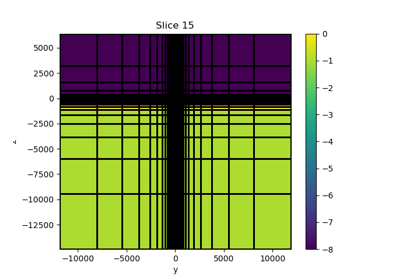simpeg.electromagnetics.natural_source.receivers.Impedance#
- class simpeg.electromagnetics.natural_source.receivers.Impedance(locations_e, locations_h=None, orientation='xx', component='real', storeProjections=False)[source]#
Bases:
_ElectricAndMagneticReceiverReceiver class for 1D, 2D and 3D impedance data.
This class is used to simulate data types that can be derived from the impedance tensor:
\[\begin{split}\begin{bmatrix} Z_{xx} & Z_{xy} \\ Z_{yx} & Z_{yy} \end{bmatrix} = \begin{bmatrix} E_x^{(x)} & E_x^{(y)} \\ E_y^{(x)} & E_y^{(y)} \end{bmatrix} \, \begin{bmatrix} H_x^{(x)} & H_x^{(y)} \\ H_y^{(x)} & H_y^{(y)} \end{bmatrix}^{-1}\end{split}\]where superscripts \((x)\) and \((y)\) denote signals corresponding to incident planewaves whose electric fields are polarized along the x and y-directions respectively. Electric and magnetic fields do not need to be simulated at the same location, so this class can be used to simulate quasi-impedance data; i.e. where the electric fields are measured at a base station.
Note that in
simpeg, natural source EM data are defined according to standard xyz coordinates; i.e. (x,y,z) is (Easting, Northing, Z +ve up).In addition to measuring the real or imaginary component of an impedance tensor element \(Z_{ij}\), the receiver object can be set to measure the the apparent resistivity:
\[\rho_{ij} = \dfrac{| Z_{ij} \, |^2}{\mu_0 \omega}\]or the phase angle:
\[\phi_{ij} = \frac{180}{\pi} \, \tan^{-1} \Bigg ( \dfrac{Im[Z_{ij}]}{Re[Z_{ij}]} \Bigg )\]where \(\mu_0\) is the permeability of free-space and \(\omega\) is the angular frequency in rad/s. The phase angle is represented in degrees and is computed by:
- Parameters:
- locations_e(
n_loc,n_dim) array_like Locations where the electric fields are measured.
- locations_h(
n_loc,n_dim) array_like,optional Locations where the magnetic fields are measured. Defaults to the same locations as electric field measurements, locations_e.
- orientation{‘xx’, ‘xy’, ‘yx’, ‘yy’}
Receiver orientation. Specifies whether the receiver’s data correspond to the \(Z_{xx}\), \(Z_{xy}\), \(Z_{yx}\) or \(Z_{yy}\) impedance. The data type is specified by the component input argument.
- component{‘real’, ‘imag’, ‘apparent_resistivity’, ‘phase’, ‘complex’}
Data type. For the impedance element \(Z_{ij}\) specified by the orientation input argument, the receiver can be set to compute the following: - ‘real’: Real component of the impedance (V/A) - ‘imag’: Imaginary component of the impedance (V/A) - ‘rho’: Apparent resistivity (\(\Omega m\)) - ‘phase’: Phase angle (degrees) - ‘complex’: The complex impedance is returned. Do not use for inversion!
- storeProjectionsbool
Whether to cache to internal projection matrices.
- locations_e(
Attributes
Data type; i.e. "real", "imag", "apparent_resistivity", "phase".
Locations of the two field measurements.
Electric field measurement locations
Magnetic field measurement locations
Number of data associated with the receiver object.
Receiver orientation.
Universal unique identifier
Methods

